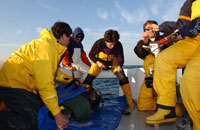Call it what you will..."an international disgrace" or "pirates of the Mediterranean" - there's no question that things have gotten out of hand in the eastern Atlantic bluefin tuna fishery, particularly in the Mediterranean Sea. Recent quotas have been set twice as high as recommended by scientists, and illegal fishing has resulted in landings twice again as high. A recent paper published in the journal, Conservation Letters, predicts that the eastern Atlantic population will decline 75% between 2005 and 2011, and remarkably in some years, every adult will be caught (McKenzie et al., 2009).
At its November 2008 meeting, ICCAT reduced the 2009 eastern quota from 27,500 to 22,000 metric tons (mt), a step in the right direction although scientists have shown that a further quota reduction to 15,000 mt - or likely even 8,000 mt - is necessary to reverse the decline. Turkey was given 683 mt of the new quota, the seventh highest allocation of the fifteen parties that receive a share of the eastern Atlantic catch. The Turkish government was not satisfied with this quota and has filed a formal objection to the ICCAT ruling, vowing to unilaterally set a quota for its fishers. Similarly defiant, Turkey has already been documented landing tons of fish below the 30 kg minimum size.
Likewise, despite proclamations of compliance in the 2009 fishery by the European Community (EC) on behalf of its member fleets, there appears to be continued illegal activity within the EC fishery, with media reports of undersized fish being landed in Italy. Apparently the EC's newly added monitoring and control measures are insufficient.
All this, and we're only 1 month into the fishing season. Estimated landings in the eastern Atlantic in recent years top 60,000 mt. All eyes will be on the Med until the major purse seine fishery closes on June 15th to gauge to what extent the new 22,000 mt quota is adhered to by the fishery. Tag-A-Giant's electronic tagging research has demonstrated unequivocally that fish from the Mediterranean Sea enter North America's coastal waters to feed before returning east to breed. The overfishing in the Med - both "legal" and illegal - has hurt our western fisheries. Let's hope that the 2009 eastern fishery achieves a much higher level of compliance and commitment to science-based management.
Monday, May 18, 2009
Friday, May 1, 2009
Tuna on a Treadmill
Although we often focus on the work we do in the wild, tagging and tracking tunas in their migrations across the seas, there is also a massive research effort that goes on every day in our Tuna Research and Conservation Center here in Pacific Grove, CA -- a unique collaboration between Stanford University and the Monterey Bay Aquarium. For the past several weeks, we have been using a large apparatus called a "respirometer" to study the metabolic rate of tunas under different, controlled conditions. This work allows us to answer questions about how these animals work - how efficiently they swim at different speeds, and how they function at different temperatures.
Jake Nogueira from the Tuna Research and Conservation Center explains how the tuna respirometer works.
In our most recent experiment, we are studying tunas that have been outfitted with special tags that monitor their heart rate, and we have been observing their metabolic rate and internal temperature following feeding. When these data are combined, we hope to gain insights into the patterns we observe in tags on wild fish -- leading to a more complete understanding of how and when they feed in the wild, and how they use the energy from the food they eat. Ultimately, this will allow us to better understand how these apex predators fit into the broader open ocean ecosystem, and what resources they need to survive.
Jake Nogueira from the Tuna Research and Conservation Center explains how the tuna respirometer works.
In our most recent experiment, we are studying tunas that have been outfitted with special tags that monitor their heart rate, and we have been observing their metabolic rate and internal temperature following feeding. When these data are combined, we hope to gain insights into the patterns we observe in tags on wild fish -- leading to a more complete understanding of how and when they feed in the wild, and how they use the energy from the food they eat. Ultimately, this will allow us to better understand how these apex predators fit into the broader open ocean ecosystem, and what resources they need to survive.
Subscribe to:
Posts (Atom)



